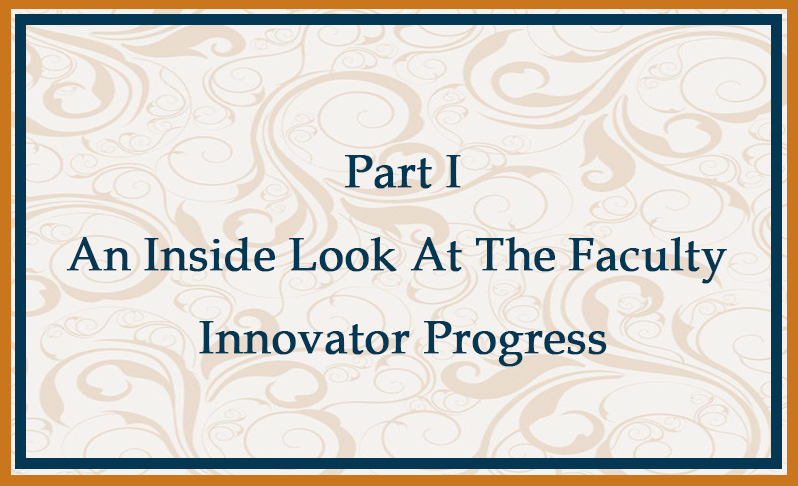Traditionally, when groups go to a non-work area for a day of training, the event is called a retreat. Since the word retreat carries negative connotations—especially as a military term meaning to fall back—we always describe our one-day workshops as progresses, a noun that always suggests a movement forward, a journey to a goal.
One goal of the Faculty Innovator (FI) Executive Committee (three unit directors plus the FI Coordinator) is to establish professional development sessions. After all, in all the official documents on our website, FIs are referred to as “trained.” The main problem in training our cadre revolves around a suitable time all are free. During the fall semester, we held bi-weekly, one-hour meetings, but these sixty-minute sessions usually concentrated on distributing key information and putting out the fire of the moment rather than actually learning how to accomplish something like a peer observation.
Related Reading: The Great Professional Learning Community Experiment
A comprehensive examination of free six-hour blocks for FIs during the semester obviously concluded such periods did not exist. What we learned is that really only two good training times for such blocks exist: sometime during the summer and in the two-week period after the holiday break and before the start of the spring semester. Unfortunately, we used last summer’s window mostly for an organizational meeting, so our only training came in early January.
Developing The Executive Committee Agenda
Our Executive Committee met twice in early January to set the agenda. The topics were easy to discover; the hard part consisted of creating the proper environment. In a recent episode of the TV show Limitless, the hero, Brian, puts on a training session for his FBI handlers in a way he considers interesting by using a makeshift storyboard with a mobile (as over a baby’s crib). Unimpressed, the female head of the FBI smugly reminds him, “We do have PowerPoint.” The point is that so many training sessions we have attended in the past five years have depended heavily on PowerPoint, and as great believers in “PowerPoint promotes passivity,” we wanted to avoid that technology and give our FIs a fun event that demanded active learning. Not only did a six-hour session demand engagement to keep them there the entire time, but we wanted to reinforce non-passive learning paradigms.
As a result, we came up with the following agenda:
8:45-9:00 Meet, Greet, and Eat (we provided a healthy breakfast)
9:00-9:05 Welcome/Preview of Goals
9:05-10:05 Envisioning the Role of the FI
10:05-10:15 Break
10:15-11:15 15-Minutes to Innovation (short modules for web PD)
11:15-12:00 Lunch and Video Interviews
12:00-1:00 Best Practices for Faculty Consultation
1:00-2:00 Best Practices for Peer Observation of Teaching
2:00-2:10 Break
2:10-2:35 Faculty Development in the College and Department
2:35-3:00 Debrief
Defining Characteristics And Roles of A Faculty Innovator
But, as we noted earlier, the key wasn’t what we did, but how we did it. We started with the FI Coordinator facilitating a group discussion wherein all ten participants brainstormed the characteristics of the ideal FI. As the group called out roles, one of the Executive Committee served as scribe, listing the roles on a flip chart. We then repeated the process with the question: what accomplishments define a good FI candidate? The ten FIs were then grouped into five pairs, who were asked to determine the top three roles of FIs. As in speed-dating, they were re-paired to consider the top three items the campus needs from FIs. Eventually everyone reported out with the items on the flip charts receiving each pair’s votes. The result was a refinement of FI duties.
Listing Critical Pedagogical Strategies
The most popular exercise came after the break. Each person was given a packet of Post-Its, asked to list the five most critical pedagogical strategies (one/Post-It), and encouraged to place the Post-Its on a white board. The Post-Its were then regrouped in columns so that the FIs could tell instantly which Post-Its proved the most popular. The FIs were re-paired and given twenty minutes to create the outline of a video module on the subject and, using materials given them in the middle of the room, were asked to create a low-res prototype that embodied the essence of their module. Each team then, using their prototype, pitched its module. The winner got to write a script for their video that we will actually create this semester and place on our professional development on demand channel, the Faculty Innovator Network.
Next time we’ll go into what else happened to make our progress such a resounding success.
Author
 Ph.D Hal Blythe writes literary criticism to mystery stories. In addition to the eleven books he’s published with New Forums, Hal has collaborated on four books on a variety of subjects, over 1000 pieces of fiction/nonfiction, and a host of television scripts and interactive mysteries performed by their repertory company. He is currently co-director of the Teaching and Learning Center for Eastern Kentucky University. Meet Hal Blythe.
Ph.D Hal Blythe writes literary criticism to mystery stories. In addition to the eleven books he’s published with New Forums, Hal has collaborated on four books on a variety of subjects, over 1000 pieces of fiction/nonfiction, and a host of television scripts and interactive mysteries performed by their repertory company. He is currently co-director of the Teaching and Learning Center for Eastern Kentucky University. Meet Hal Blythe.



